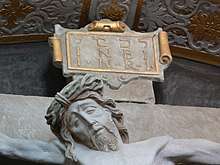John 19
| John 19 | |
|---|---|
.jpg) John 19:1-7 on the verso side of Papyrus 90, written AD 150-175. | |
| Book | Gospel of John |
| Bible part | New Testament |
| Order in the Bible part | 4 |
| Category | Gospel |
John 19 is the nineteenth chapter of the Gospel of John in the New Testament of the Christian Bible. It records the events on the day of the crucifixion of Jesus Christ, until His burial.[1] The book containing this chapter is anonymous, but early Christian tradition uniformly affirmed that John composed this Gospel.[2]
Text

- The original text is written in Koine Greek.
- Some most ancient manuscripts containing this chapter are:
- Papyrus 90 (AD 150-175; extant: verses 1-7)
- Papyrus 66 (ca. AD 200; complete)
- Papyrus 121 (3rd century; extant: verses 17-18,25-26)
- Codex Vaticanus (AD 325-350)
- Codex Sinaiticus (AD 330-360)
- Codex Bezae (ca. AD 400)
- Codex Alexandrinus (AD 400-440)
- Papyrus 60 (ca. AD 700; extant: verses 1-26)
- This chapter is divided into 42 verses.
Places
Events recorded in this chapter took place in Jerusalem.
Structure
The New King James Version organises this chapter as follows:
- John 19:1-4 = The Soldiers Mock Jesus (continued from John 18:38-40; Matthew 27:15-31; Mark 15:6-20; Luke 23:13-25)
- John 19:5-16 = Pilate’s Decision (Matthew 26:57)
- John 19:17-24 = The King on a Cross (Matthew 27:32-38; Mark 15:21-27; Luke 23:26,33-43)
- John 19:25-27 = Behold Your Mother
- John 19:28-30 = It Is Finished (Matthew 27:45-50; Mark 15:33-37; Luke 23:44-46)
- John 19:31-37 = Jesus’ Side Is Pierced
- John 19:38-42 = Jesus Buried in Joseph’s Tomb (Matthew 27:57-61; Mark 15:42-47; Luke 23:50-56)
Cross references
Verse 3
Cross reference: Matthew 27:29, Matthew 27:30; Mark 15:18; John 18:22
Verse 19

- Now Pilate wrote a title and put it on the cross. And the writing was:
Verse 19 in Greek
Textus Receptus/Majority Text:
- ἔγραψεν δὲ καὶ τίτλον ὁ Πιλάτος, καὶ ἔθηκεν ἐπὶ τοῦ σταυροῦ· ἦν δὲ γεγραμμένον,
- Ἰησοῦς ὁ Ναζωραῖος ὁ βασιλεὺς τῶν Ἰουδαίων.
Transliteration:
- egrapsen de kai titlon ho Pilatos, kai ethēken epi tou staurou; ēn de gegrammenon,
- IĒSOUS O NAZŌRAIOS O BASILEUS TŌN IOUDAIŌN.
Verse 19 in Latin
- scripsit autem et titulum Pilatus et posuit super crucem erat autem scriptum
- Iesus Nazarenus rex Iudaeorum
Verse 20
Verse 21
Verse 22
Verse 22 in Greek
Textus Receptus/Majority Text:
- ἀπεκρίθη ὁ Πιλάτος, Ὃ γέγραφα, γέγραφα
Transliteration:
- apekrithē o Pilatos o gegrapha gegrapha
Verse 22 in Latin
- respondit Pilatus quod scripsi scripsi
Verse 23
Verse 24
- They said therefore among themselves, “Let us not tear it, but cast lots for it, whose it shall be,”
- that the Scripture might be fulfilled which says:
- “They divided My garments among them,
- And for My clothing they cast lots.”
- Therefore the soldiers did these things. (NKJV)[9]
Citing: Psalm 22:18
Verse 25
Verse 26
Verse 27
- Then He said to the disciple,
- “Behold your mother!”
- And from that hour that disciple took her to his own home. (NKJV)[12]
"That hour" may indicate that "they did not wait at the cross to see the end and the disciple took her to his own home"; εἰς τὰ ἴδια, see John 1:11, John 16:32. Mary would live with John and his natural mother, Salome, who is also Mary's sister.[13]
Verse 28
- After this, Jesus, knowing that all things were now accomplished, that the Scripture might be fulfilled, said,
Referring to: Psalm 69:21
Verse 29
- Now a vessel full of sour wine was sitting there; and they filled a sponge with sour wine,
- put it on hyssop, and put it to His mouth. (NKJV)[15]
- Referring to: Psalm 69:21
- Cross reference: Matthew 27:34; Mark 15:23; Luke 23:36
Verse 30
- So when Jesus had received the sour wine, He said,
- “It is finished!”
- And bowing His head, He gave up His spirit. (NKJV)[16]
Verse 30 in Greek
Textus Receptus/Majority Text:
- ὅτε οὖν ἔλαβε τὸ ὄξος ὁ Ἰησοῦς, εἶπε,
- Τετέλεσται·
- καὶ κλίνας τὴν κεφαλήν, παρέδωκε τὸ πνεῦμα.
Transliteration:
- ote oun elaben to oxos o Iēsous eipen
- tetelestai
- kai klinas tēn kephalēn paredōken to pneuma
Verse 30 in Latin
- cum ergo accepisset Iesus acetum dixit
- consummatum est
- et inclinato capite tradidit spiritum
Verse 31
- Therefore, because it was the Preparation Day, that the bodies should not remain on the cross on the Sabbath (for that Sabbath was a high day), the Jews asked Pilate that their legs might be broken, and that they might be taken away.[17]
See also
- Burial of Jesus
- Crucifixion of Jesus
- Jerusalem
- Jesus Christ
- "Jesus, King of the Jews"
- Joseph of Arimathea
- Nazareth
- Nicodemus
- Pontius Pilate
- Sabbath
- Other related Bible parts: Exodus 12, Numbers 9, Psalm 22, Psalm 34, Psalm 69, Zechariah 12, Matthew 2, Matthew 27, Mark 15, Luke 23, John 3, John 18
References
- ↑ Halley, Henry H. Halley's Bible Handbook: an abbreviated Bible commentary. 23rd edition. Zondervan Publishing House. 1962.
- ↑ Holman Illustrated Bible Handbook. Holman Bible Publishers, Nashville, Tennessee. 2012.
- ↑ John 19:3
- ↑ John 19:19
- ↑ John 19:20
- ↑ John 19:21
- ↑ John 19:22
- ↑ John 19:23
- ↑ John 19:24
- ↑ John 19:25
- ↑ John 19:26
- ↑ John 19:27
- ↑ Marcus Rods. II: The Gospel Of St. John. In: The Expositor's Greek Testament (Volumes 1). W. Robertson Nicoll (Editor). 1956. ASIN: B002KE6V1Q
- ↑ John 19:28
- ↑ John 19:29
- ↑ John 19:30
- ↑ John 19:31
External links
| Preceded by John 18 |
Chapters of the Bible Gospel of John |
Succeeded by John 20 |